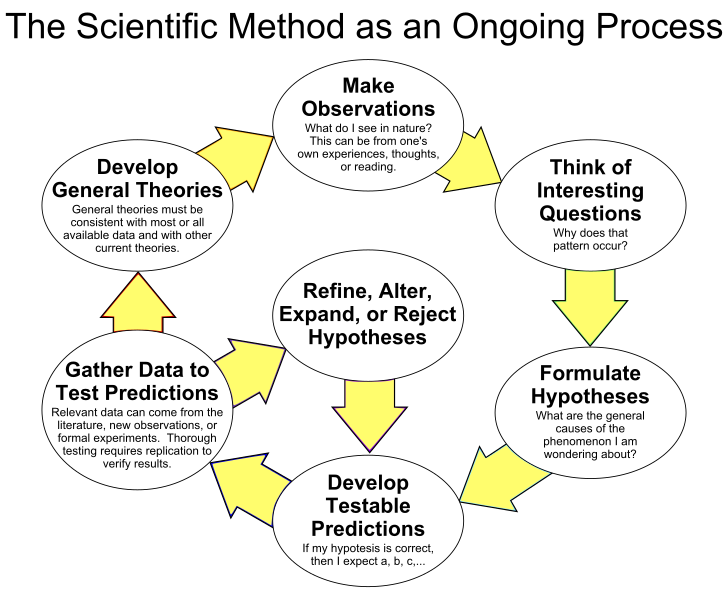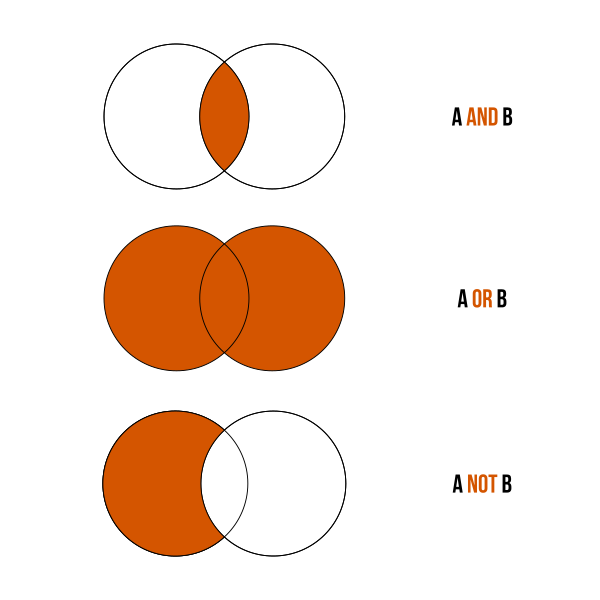OCR Specification focus:
‘Use online and offline research skills to consult reliable scientific sources, including textbooks and scholarly materials relevant to the investigation.’
Effective research skills are essential for physics investigations. Students must locate, evaluate, and interpret reliable scientific sources, ensuring that their findings and methods are valid, relevant, and trustworthy.
Research Skills in Physics
Research in physics combines critical thinking with methodological rigour, allowing students to gather evidence that supports experimental design, data interpretation, and analysis.

A clear, labelled diagram of the scientific method presented as an iterative cycle. It emphasises how research questions, experiments, and analysis inform each other to improve reliability. Extra steps shown (e.g., feedback loops) extend detail beyond the syllabus, but help visualise iterative refinement. Source.
Developing Effective Research Habits
Successful scientific research requires consistent, systematic approaches:
Defining a clear objective: Begin by articulating the aim of the research, such as verifying a physical law or understanding a particular instrument.
Identifying key concepts: Break the topic into specific terms—e.g. “wave interference,” “electric field strength”—to structure searches efficiently.
Selecting suitable resources: Determine whether the information needed is theoretical (textbook-based), empirical (journal data), or procedural (laboratory methods).
Students should use keywords, Boolean operators (AND, OR, NOT), and quotation marks when searching databases to refine and focus their queries.

A succinct graphic showing how AND, OR, and NOT affect search results. This aligns with research skills for locating reliable sources efficiently. The minimalist layout avoids clutter and focuses on the three operators only. Source.
Types of Sources
Reliable sources can be divided into primary, secondary, and tertiary categories:
Primary sources: Original research papers, laboratory data, or direct experimental results published in peer-reviewed journals.
Secondary sources: Interpretations or analyses of primary work, such as review articles or textbooks.
Tertiary sources: Summaries or compilations like encyclopaedias, glossaries, or data handbooks.
Each type has a role: primary sources offer original evidence; secondary sources provide context; tertiary sources aid quick reference.
Evaluating Source Reliability
Reliability depends on the authenticity, accuracy, and bias of a source. Students must critically assess:
Authorship: Is the author a recognised scientist or institution?
Publication medium: Is the work peer-reviewed or from a verified academic publisher?
Currency: Are the findings up to date, especially for technology and instrumentation topics?
Evidence quality: Does the author cite data and explain methodology transparently?
Bias detection: Are claims supported by balanced reasoning rather than opinion or sponsorship?
Reliable sources such as Nature, The European Physical Journal, and Physics Education are preferred over non-peer-reviewed materials or informal websites.
Research Using Digital Tools
Modern research skills involve proficiency with digital platforms and academic databases.
Examples include:
Google Scholar and PubMed for journal access.
Physics-specific databases like arXiv for preprints and emerging theories.
Institutional databases for subscription-based resources.
When using these, students should note DOI identifiers, publication dates, and citation counts to determine the relevance of results.
The Role of Textbooks and Offline Resources
While digital research dominates, textbooks remain vital for conceptual clarity and structured learning. Authoritative OCR-aligned books ensure content accuracy and consistent notation. Laboratory handbooks and manufacturer manuals provide details on equipment calibration, error sources, and experimental design — indispensable when planning investigations.
Academic Integrity and Plagiarism
Proper research practice involves crediting others’ work and avoiding plagiarism — using another’s words or ideas without acknowledgment.
Plagiarism: The presentation of another person’s ideas or work as one’s own without proper citation or acknowledgment.
Students must use consistent referencing systems to indicate where external information has been applied. Paraphrasing and quotation are both acceptable provided they are clearly attributed.
Citation and Referencing Techniques
The Harvard referencing system is commonly accepted in OCR Physics coursework. It requires:
In-text citation: (Author, Year).
Full reference list entry: Author, Initials. (Year). Title. Publisher.
Example: (Tipler, 2008) in-text, with a corresponding full entry at the end of the report.
For online sources, include the URL and access date, e.g.:
HyperPhysics (2024). “Magnetic Flux.” Available at: https://hyperphysics.phy-astr.gsu.edu (Accessed: 31 October 2025).
Researching Experimental Contexts
Research does not end with theory; it informs methodology and apparatus selection. When preparing a practical investigation, background research helps to:
Identify the best instruments for accurate measurement.
Predict expected data trends using established physical laws.
Compare current results with existing literature.
Students should evaluate experimental reports to identify systematic errors, limitations, and recommended techniques that may apply to their own investigations.
Using Data Repositories and Statistical Sources
Many investigations benefit from secondary data. Repositories such as the National Physical Laboratory (NPL) or NIST provide authoritative datasets for calibration constants, uncertainty values, and standard measurements. Data must always include units, uncertainties, and measurement conditions to ensure comparability.
The Importance of Peer Review
Peer Review: The process where independent experts evaluate a study before publication to ensure accuracy, validity, and originality.
Peer-reviewed material ensures scientific integrity. Non-peer-reviewed websites or informal blogs should only be used for conceptual overviews, never as final evidence in investigations.
Managing and Recording Research
Good research practice requires systematic recording of all sources consulted. Students should:
Maintain a research log listing article titles, authors, and notes on relevance.
Use reference management software such as Zotero or Mendeley to organise citations.
Record page numbers and quotation marks for direct references.
Research logs help trace the reasoning process behind each experimental decision and support evaluation in reports.
Integrating Research into Reports
When writing scientific reports, sources must be integrated coherently:
Begin with background theory drawn from textbooks.
Support claims with peer-reviewed data.
Use citations to connect the experiment with the wider field.
Quoting a law or principle must always include its origin — for instance, referencing the source of a derivation or the equipment manual used.
Reliability and Cross-Verification
To ensure reliability, students should cross-verify information from multiple sources. If two independent references confirm similar data or theory, confidence in accuracy increases. Conflicting results should be critically analysed, not ignored — this process reflects the scientific method itself.
In conclusion, mastering research skills empowers OCR Physics students to approach investigations confidently, making informed, evidence-based decisions using high-quality, verifiable, and properly referenced sources.
FAQ
Credible scientific websites are hosted by educational institutions, recognised research organisations, or professional societies (e.g. university domains ending in .ac.uk or government sites ending in .gov.uk). They:
Clearly cite data sources and authors.
Are updated regularly with accurate, referenced information.
Avoid sensationalist language and advertisements.
Unreliable sites often lack author details, peer review, or verifiable citations, and may promote untested claims.
Students can:
Check the journal’s website for statements confirming a peer-review process.
Look for “Received,” “Revised,” and “Accepted” dates on the paper — these indicate formal review.
Search the journal on databases such as Scopus or Web of Science, which list peer-reviewed publications.
Avoid assuming that all open-access or online materials are peer-reviewed; many preprints are not.
Referencing ensures transparency by allowing others to trace methods, data sources, and theoretical foundations.
It also demonstrates academic honesty and prevents plagiarism. In experimental contexts, it validates:
Calibration data or constants from standard sources.
Equipment manuals used for procedural details.
Published uncertainty values or formulae referenced in analysis.
Proper referencing strengthens the credibility of the student’s investigation and conclusions.
Citing means acknowledging the source of an idea or data point in your own words. Example: According to Tipler (2008)...
Quoting involves using the author’s exact words within quotation marks and giving a page reference.
Citing is preferred for conciseness and understanding, while quoting should be reserved for precise definitions, laws, or statements that cannot be rephrased without losing meaning.
Efficient organisation prevents citation errors and information loss. Recommended methods include:
Using reference managers such as Zotero or Mendeley to store and tag papers.
Maintaining a digital research log that records article titles, URLs, and short summaries.
Grouping references by topic (e.g. apparatus design, theoretical background, error analysis).
Consistent organisation supports clearer writing and quicker access when preparing the final report.
Practice Questions
Question 1 (2 marks)
State two features that make a scientific source reliable when conducting physics research.
Mark scheme:
Award 1 mark for each correct feature (maximum 2 marks).
Author is a recognised expert or institution. (1 mark)
Source is peer-reviewed or published in a reputable scientific journal. (1 mark)
Alternative acceptable answers: clearly stated methodology, up-to-date data, accurate referencing. (Any two for full marks)
Question 2 (5 marks)
A student is preparing for a physics investigation and uses information from an online blog, a peer-reviewed journal, and a university textbook.
Explain how the student can evaluate and reference these sources effectively to ensure academic integrity and reliability in their report.
Mark scheme:
Clear explanation that peer-reviewed journals are the most reliable due to expert evaluation before publication. (1 mark)
Recognition that university textbooks are secondary sources providing validated and summarised scientific knowledge. (1 mark)
Identification that blogs may lack peer review and can contain bias, requiring careful verification of claims. (1 mark)
Explanation that all external material should be referenced using a consistent system (e.g. Harvard), including author, year, and title. (1 mark)
Statement that proper citation prevents plagiarism and supports the transparency and reproducibility of the investigation. (1 mark)

